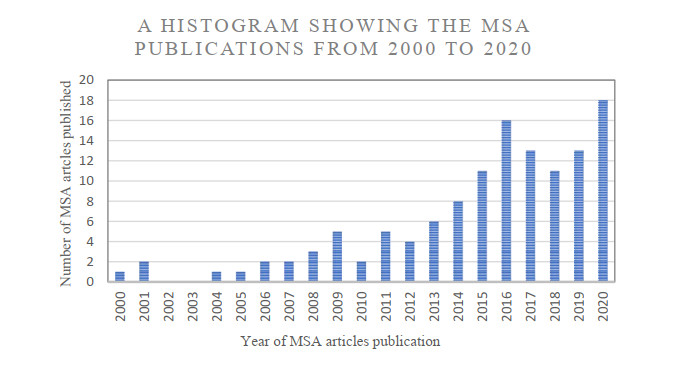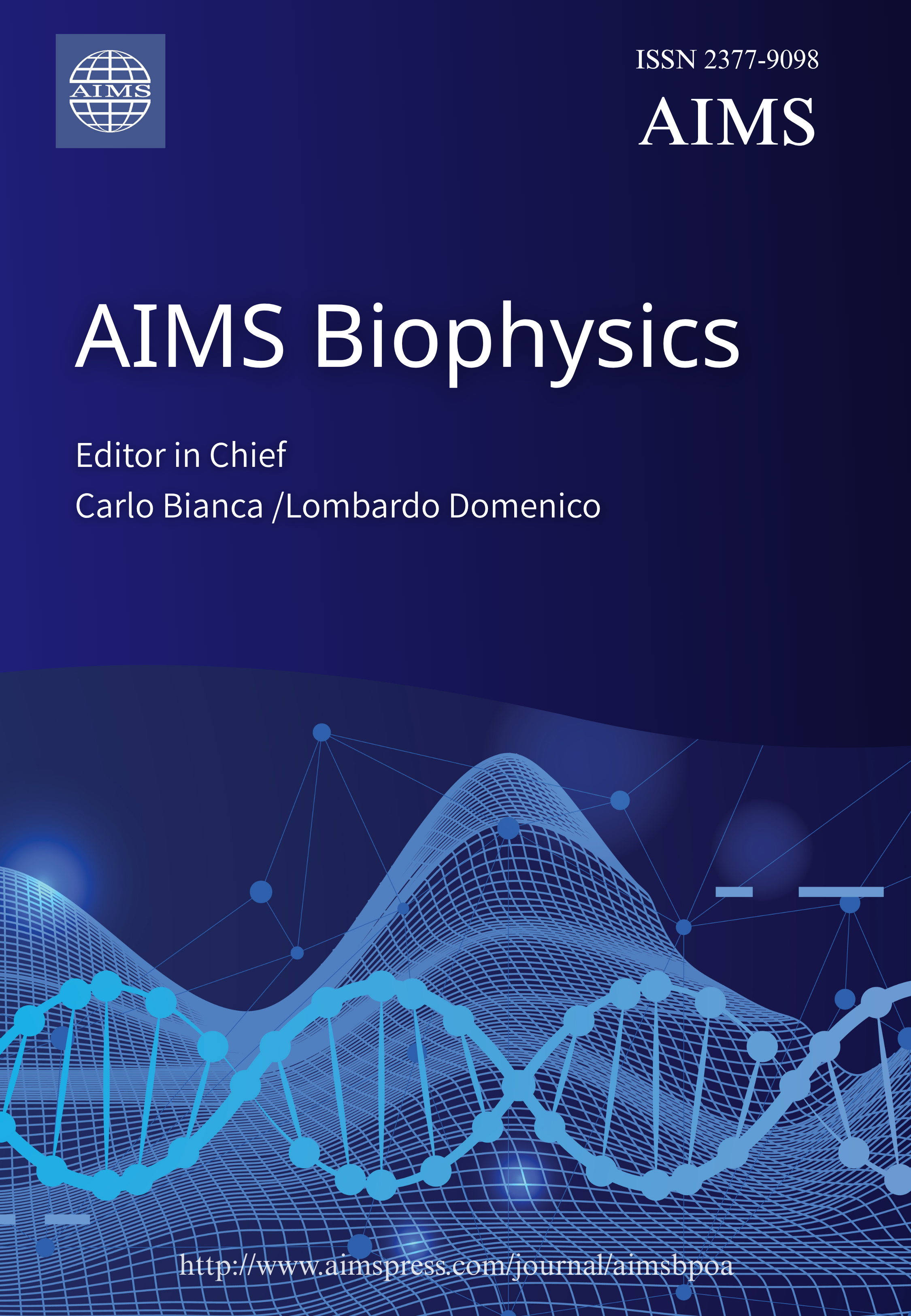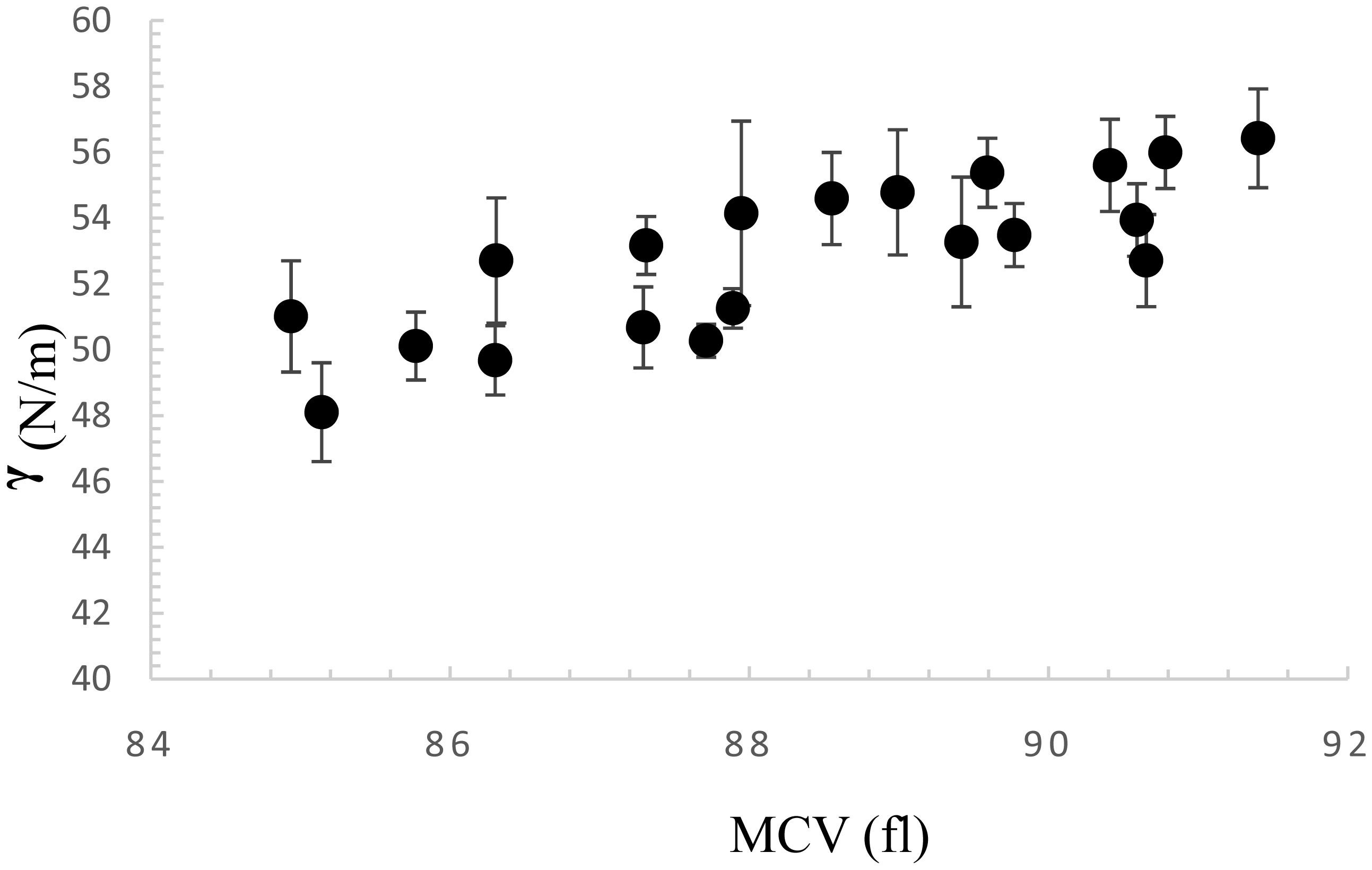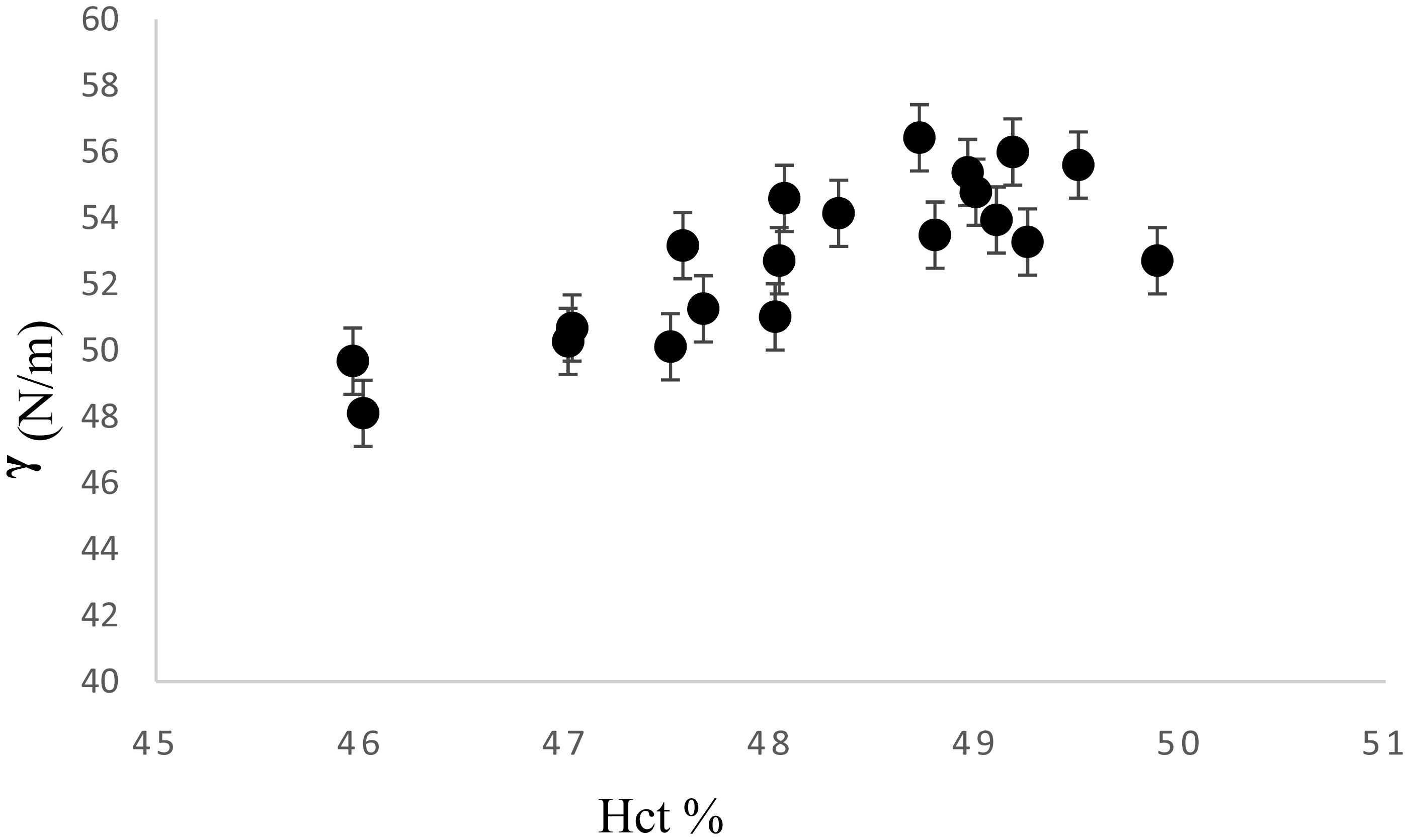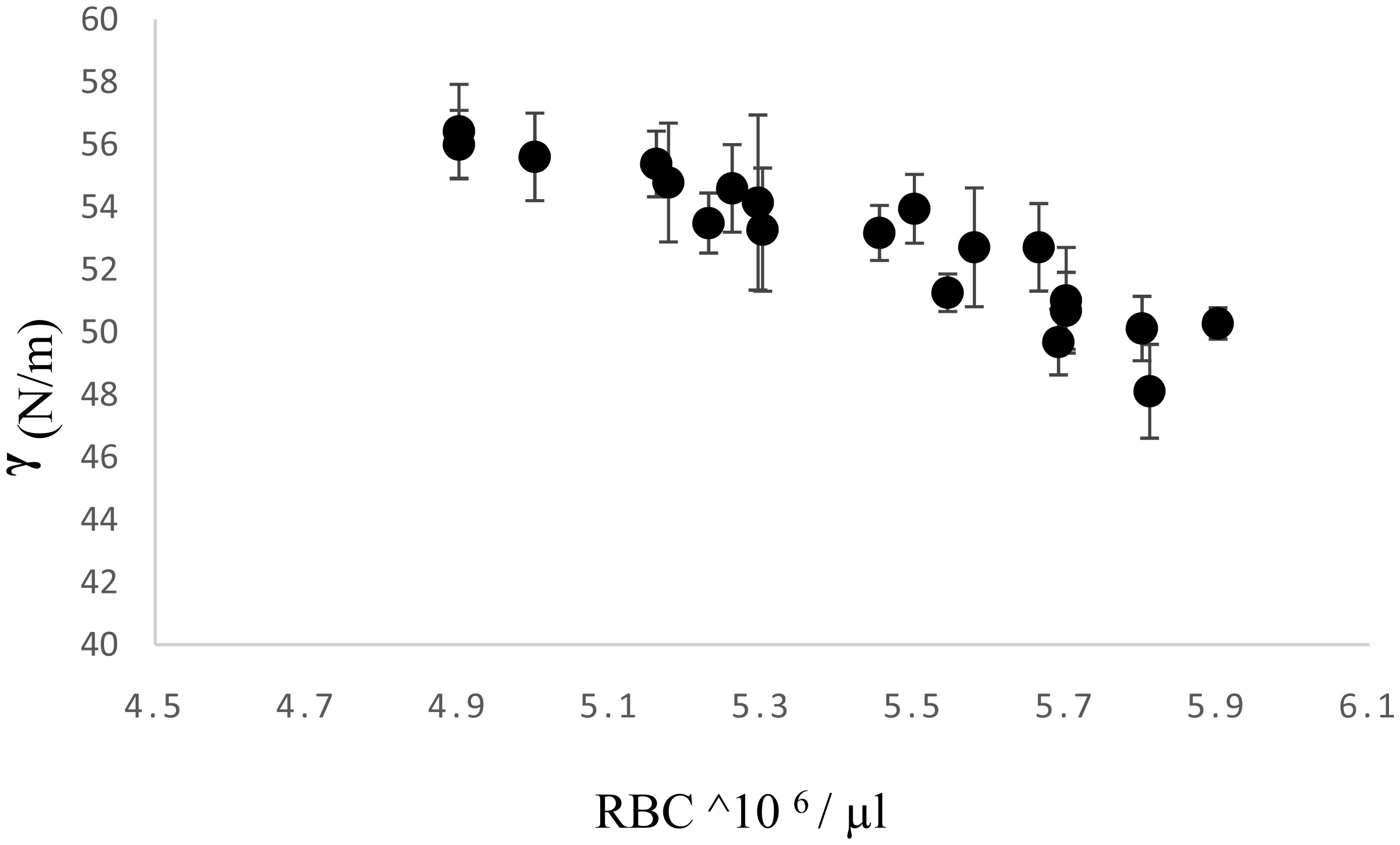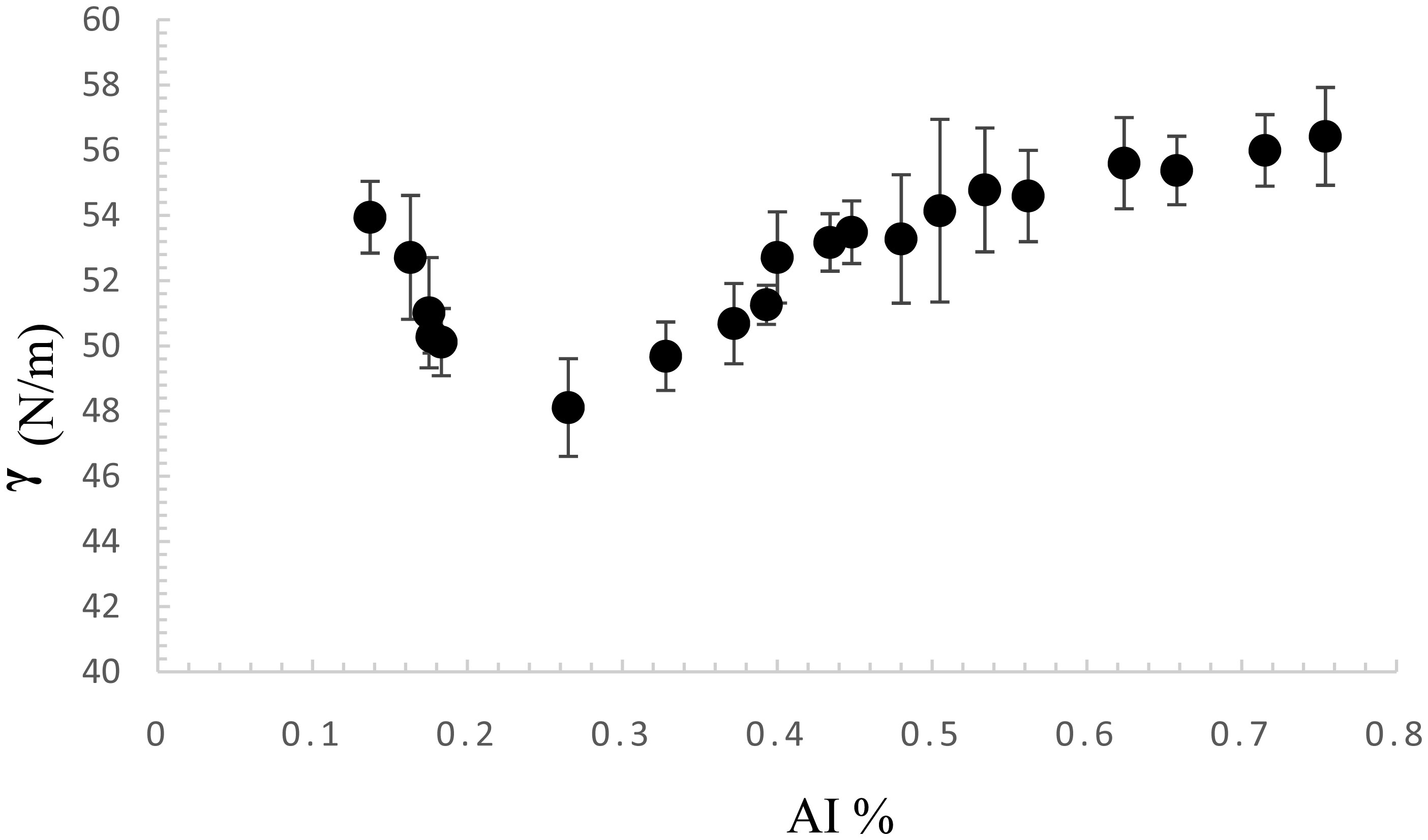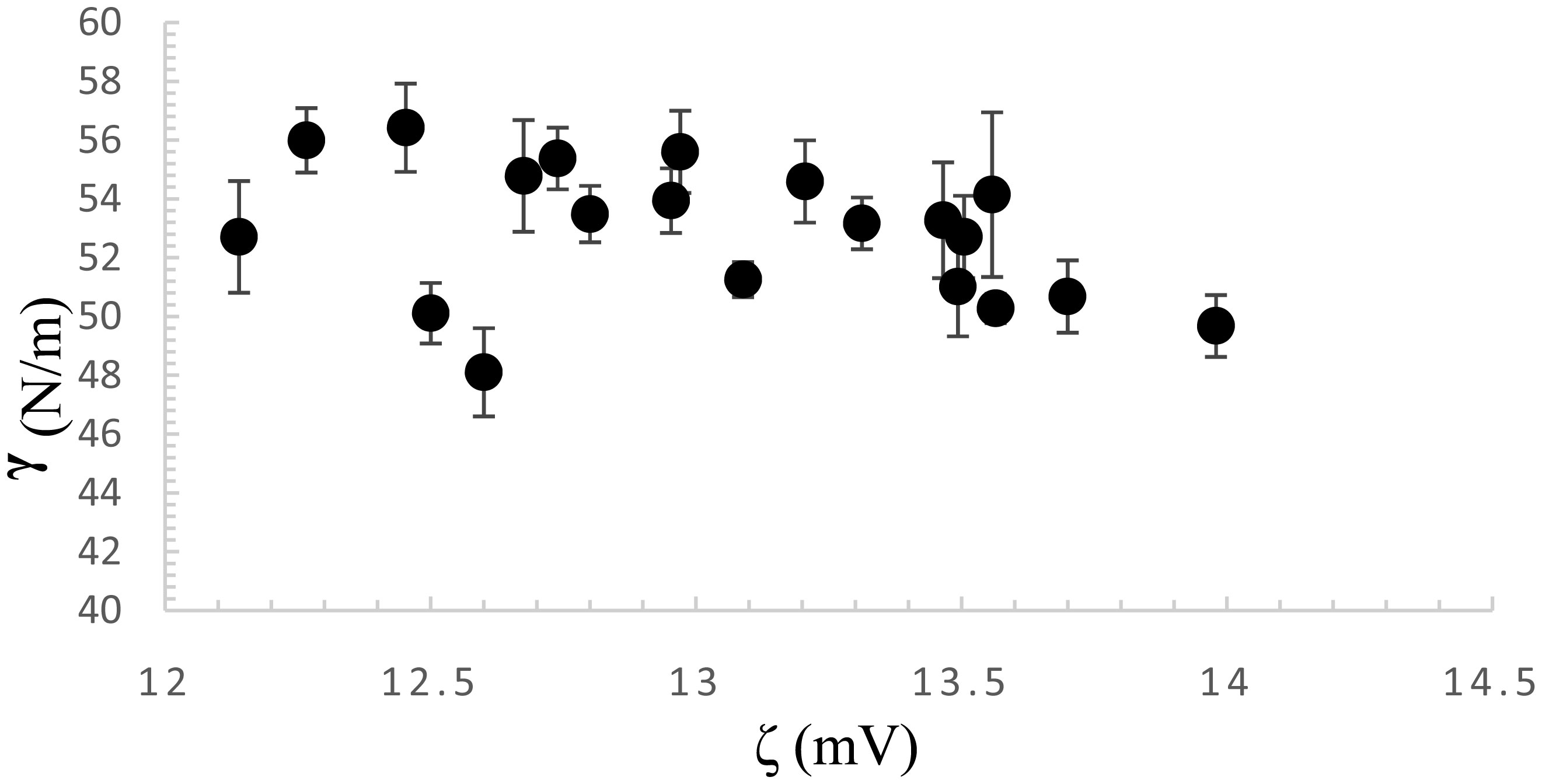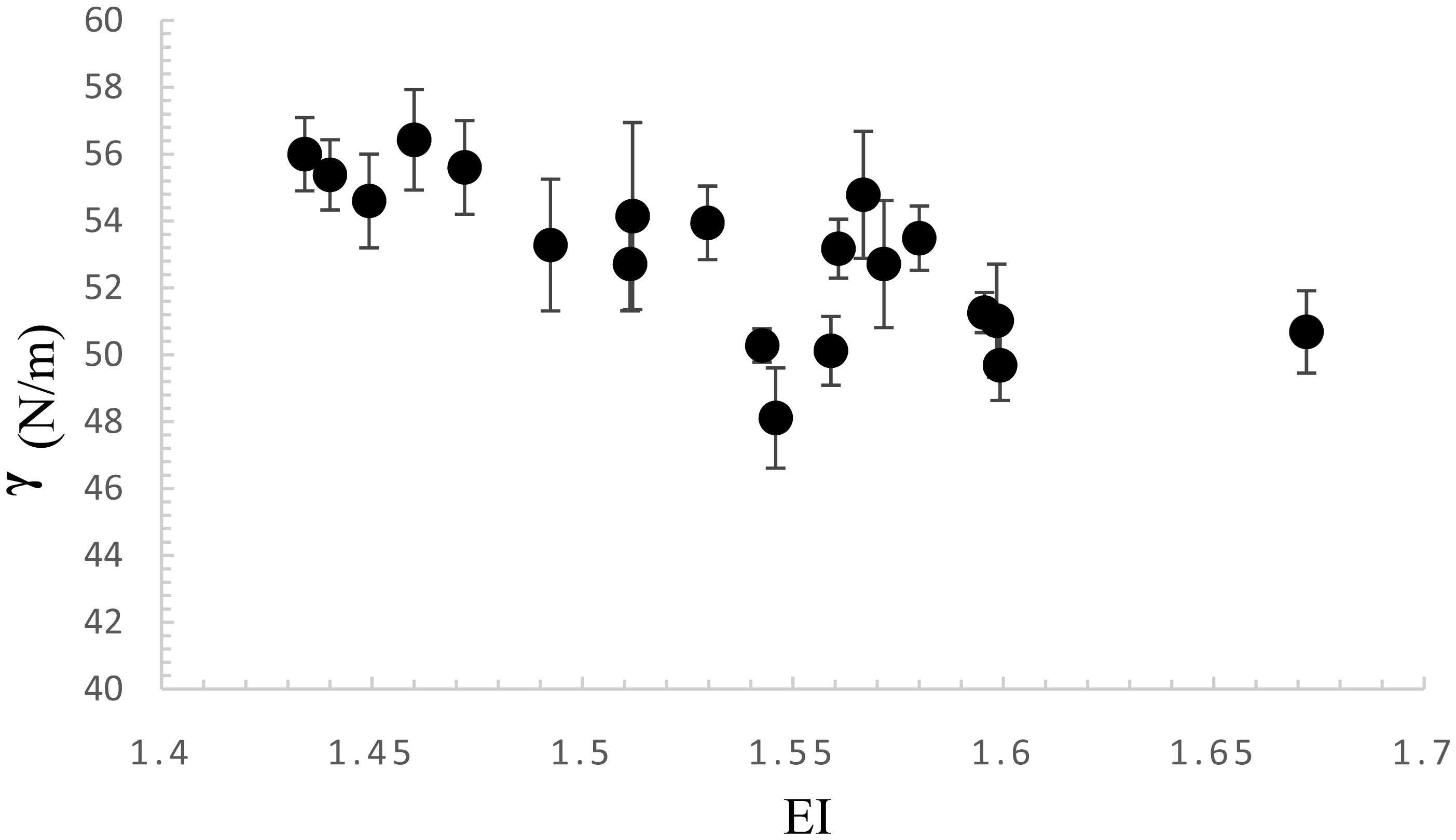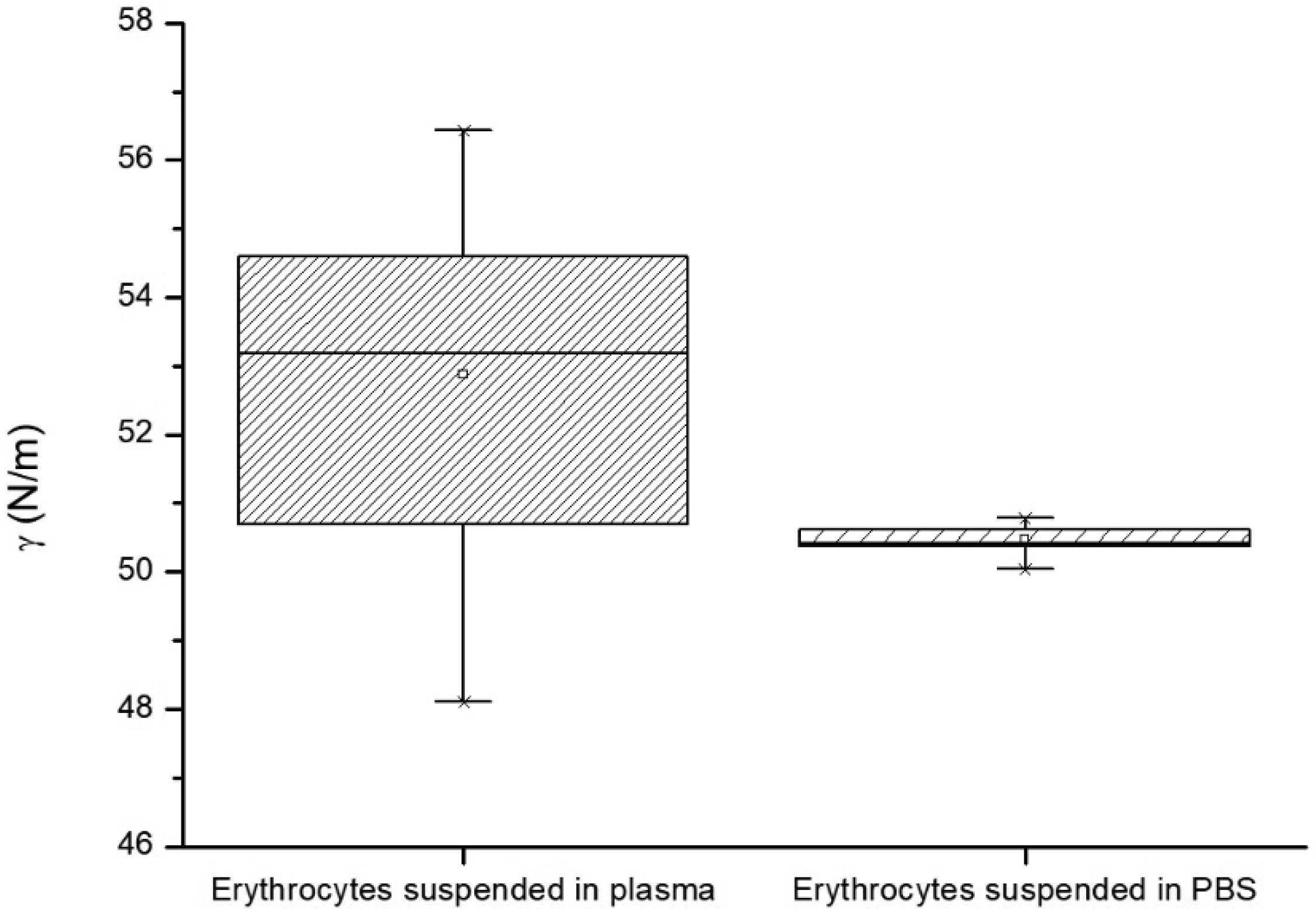Surface tension is a physical phenomenon that occurs as a result of the presence of a cohesive force between molecules of the liquid. Many biological processes depend on wetting and interfacial tension. The physical properties of the blood are of great importance according to their effect on the circulatory system. One of these physical properties is surface tension. As the blood could be treated as suspension, this study aims to study the effect of physical properties of erythrocytes on the surface tension of the blood. Blood surface tension was measured by maximum bubble pressure. This method offers the most accurate method to evaluate the surface tension of biofluid. Strong correlations between blood surface tension and mean erythrocytes volume, and the aggregation index of erythrocytes were found. No correlations between blood surface tension and erythrocytes Zeta potential and erythrocytes deformability were found. It can be concluded that not only the biochemical factors influence blood surface tension but also the physical properties of erythrocytes.
1.
Introduction
Among the 300, 000 children diagnosed with cancer annually, 80% of them live in Low and Middle Income Countries (LMICs) where there is incomplete information on paediatric cancer incidence, diagnosis distribution, and treatment outcomes [1,2,3]. While acute lymphoblastic leukemia takes the lead among paediatric patients, acute/chronic myeloid leukemia leads among adults with annual mortality rates of 0.4 and 2.8 per 100, 000 people respectively (4). Chronic myeloid leukemia also accounts for 15-20% of the newly diagnosed leukemia cases [4,5]. Leukemia treatment mainly depends on the type, disease stage, prior treatment history, age, overall condition and genetic profile. Chemotherapy ranks as the number one treatment method followed by radiotherapy, transplantation and targeted therapy as other options [6,7]. Unfortunately, chemotherapy yields adverse side effects such as poor selectivity, low therapeutic efficacy, hair loss, muscle weakening, general body weakness and high remission periods [8]. Crowley's group noted that liquid biopsies would serve as great tools for the treatment of leukemia but unfortunately represent a small proportion of the whole cancer like the solid tumors especially metastasis [9]. This is because leukemia is a liquid tumor as compared to the solid tumors like breast, prostate, cervical and so on, which can easily be targeted and treated [10,11]. Illiteracy, poverty and longer travel/wait times are associated with delays in assessment and treatment of leukemia in LMICs [12,13,14,15]. Although efforts have been made by programs such as the Glivec International Patient Assistance Program (GIPAP) to donate drugs to leukemia patients in LMICs, the incidence of the disease is still on the rise [16,17,18]. Increase in the imaging equipment has not also reduced the rising numbers due to the high maintenance costs [19]. Such costs normally involve spare parts and experts that are outsourced from developed countries thus leading to an expensive procurement process.
Modeling and simulation presents a novel approach for designing treatment technologies to handle such leukemia liquid tumours [20]. Modeling and simulation is the use of models (e.g., physical, mathematical, or logical representation of a system, entity, phenomenon, or process) as a basis for simulations to develop data utilized for managerial or technical decision making. In their experiments, many researchers have proved that Modeling and Simulation Approaches (MSAs) using superparamagnetic iron oxide nanoparticles (SPIONs) will benefit a wide range of leukemia treatment through concentrating the therapeutic effect at the target site while minimizing deleterious effects to off-target sites [21,22,23,24]. SPIONs which lie within the range of 1-20 nm are biodegradable, biocompatible and can be endocytosed into cells thus making them responsive to magnetic fields. During the focused workshop that was held in London, I. Roeder and M. d'Inverno reported that such MSAs can not only fix the existing data or predict an individual mechanism but can also challenge the stem cell concepts from which leukemia cells emanate [25]. Nanomedicine presents a great potential to specifically deliver anti-cancer drugs to the cancerous tumor without causing toxic damage to the healthy cells. Research has shown that early detection and the development of nanomedical therapy with protocol-driven treatment has led to long-term cancer survival in the Western world [27,28,29,30,31]. For instance, magnetic cell targeting provides an efficient, safe and straightforward delivery technique using SPIONs (superparamagnetic iron oxide nanoparticles). SPIONs are biodegradable, biocompatible and can be endocytosed into cells thus making them responsive to magnetic fields [26]. The aim of this study is therefore to review the trend of modeling and simulation approaches for designing and delivering cancer therapy technologies while highlighting the limited use of such technologies in LMICs. This review is also aimed at suggesting possible software platforms that can be utilised to carry out modelling and simulation for the treatment of leukemia in LMICs.
2.
Materials and methods
2.1. Search strategy
The authors carried out a systematic review of five databases namely, PMC (PubMed Central), Scopus, Google scholar, Embase and Science direct. Seven groups of key words were used to collect all studies that used a modeling and simulation approach as a tool for cancer treatment with a focus on leukemia in LMICs. These key words were searched from the title, abstract and key words of various papers from the above databases. 1. Targeted AND Cancer AND Treatment AND Modeling and Simulation OR 2. Leukemia AND Treatment AND Modeling and Simulation OR 3. Cancer AND Treatment AND Low and Middle Income Countries OR 4. Targeted AND Cancer AND Treatment AND Low and Middle Income Countries OR 5. Targeted AND Cancer AND Treatment AND Low and Middle Income Countries AND Modeling and Simulation OR 6. Targeted AND Drug AND Delivery AND Modeling and Simulation OR 7. Iron oxide nanoparticles AND Cancer AND Treatment AND Magnetic strength
2.2. Study selection
After removing duplicates, the authors reviewed the title and abstract of each article using Mendeley software. All non-English papers and those with unclear description of modeling and simulation techniques for cancer treatment in low- and middle-income countries were excluded. Conference abstracts with no full conference papers were also excluded. Only reviewed papers published between 1999 and 2020 were included.
2.3. Analysis of studies
The authors categorized the selected papers under 6 subdivisions below as abbreviated the divisions as per the United Nationa (UN) secretariat [32]
Studies that involved MSAs in high-income countries (HICs)
Studies that involved MSAs in middle-income countries (MICs)
Studies that involved MSAs in low-income countries (LICs)
Studies that involved MSAs in high- and middle-income countries (HMICs). In such studies, some authors came from HICs while the rest came from MICs.
Studies that involved MSAs in low- and middle-income countries (LMICs). In such studies, some authors came from LICs while the rest came from MICs.
Studies that involved MSAs in high-and low-income countries (HLICs). In such studies, some authors came from HICs while the rest came from LICs.
The search revealed 3077 papers across 5 databases as shown by Figure 1. After removing duplicates, 1772 papers were screened for language, clear authors, title, abstract, year of publication and journal. Additionally, using the inclusion and exclusion criteria above, 234 papers were screened out of the 1772 papers. The 234 papers were further subdivided into 110 papers that involved leukemia treatment approaches that never involved modeling and simulation and 124 papers that involved modeling and simulation. The selected 124 papers were then subdivided as per Figure 1.
3.
Discussion
3.1. Trend in the MSA publications
The analysis of these articles revealed an increasing trend in the publication of articles relating to MSAs as a tool for designing technologies used for leukemia treatment (Figure 2). Although there was some earlier research work registered before 2000, more interest was focused onto the recent studies between 2000-2020. It was assumed that such recent articles provide updated information which could easily be translated into potential development. The number of articles between 1999 and 2010 is low with a fluctuating trend that later on rises after 2010 to date. This trend decreases slightly from 16 to 11 articles between 2016 and 2018 but increases after 2018. This increase in the trend shows the level of interest gained over the years in the modeling and simulation field and clearly indicates its promising results seen by several researchers.
3.2. Nanomedicine approaches towards leukemia treatment
Nanomedicine based technologies potentially present superiority over current therapeutic practices as they can effectively deliver drugs to the affected tissues, thus reducing drug toxicity and can lead to an increased drug accumulation within a target site irrespective of the method and route of drug administration. As illustrated in Table 1, such superiority has led to an interest of coupling nanomedicine with different MSAs although such related articles are still fewer as compared to the non-nanomedical MSAs. This table shows only 23 out of 97 MSA publications incorporated the nanomedicine based technology which potentially shows some interest in the usage of targeted drug delivery.
Through, nanomedicine techniques, researchers have explored the use of gold and ferromagnetic nanoparticles as tools for diagnosis and treatment of various leukemias [33]. For example, an aptamer-based model was proposed for the treatment of acute leukemia which yielded to 10 leukemia cells per millilitre [34,35]. Progress has been presented by various researchers relating to functionalizing magnetic nanoparticles [36] with several antigens (CD19, CD20, and CD45) so as to specifically target and treat leukemia cells from mixed samples using the nanomedicine techniques. Sahoo et al, used a permanent magnet to study avidin-modified magnetic nanoparticles functionalized with CD20 so as to treat leukemia cells by using hybridoma cell line (BCRC 60427) [37,38,39,40]. Gossai et al. functionalized 15 nm AuNPs with oligonucleotides in a sequence so as to treat chronic myeloid leukemia [41]. Other studies examined the in vitro efficacy of drug-coated AuNPs on AML treatment where Song and colleagues went further to use folate receptors which are highly expressed on the tumour cells receptors [42,43,44].
Animal models, normally used for in vivo treatment of leukemia, will not follow the same pathogenesis of leukemia than humans [45]. Additionally, such models cannot replicate the complex microenvironment from which these human cancers arise. Hence, MSAs using nanoformulations may have enhanced biomarker detection, providing simpler protocols with higher sensitivity. Nanomedicines have also been shown to improve the efficacy-toxicity ratio of anticancer agents, leading to the possibility of real-time treatment in leukemia management [46]. The experimental variations in the preclinical studies using nanoparticles to tackle leukemia also contribute to their reduced clinical impact. The lack of standardized manufacturing procedures and controls, recognized by regulatory agencies also limits the clinical translation of nanoscale diagnostic assays and treatment. Although essential studies for in vivo toxicity, stability, and biodistribution are increasing, computational MSAs could provide deeper insights before moving onto in vivo studies so as to gain a broader picture of the study outcomes [47,48].
Leukemia cells highly contain heterogeneous hematological malignancies that affect people of all ages and ethnicities. Such cells usually spread widely throughout the body due to the liquid nature of many of these malignancies, as well as the complex microenvironment from which they arise. Therefore, this multifaceted genetic basis adds a lot of difficulty in generating appropriate and translational models to study them. Computational modeling and simulation models could hence have a significant and powerful tool in the study of such cancers [49]
3.3. Leukemia treatment in LMICs
In high-income countries (HICs), increased rates of survival among cancer patients are achieved through the use of protocol-driven treatment [31,50]. In comparison to HICs, differences in infrastructure, supportive care, and human resources, make compliance with protocol-driven treatment challenging for LMICs. For successful implementation of protocol-driven treatment, treatment protocols must be resource-adapted for the LMICs context, and additional supportive tools must be developed to promote protocol compliance. Using these treatment protocols, the 5-year overall survival (OS) for leukemia treatment in high-income countries is approaching 90% as compared to LMICs which is far less than 50%. Additionally, there is limited protocol data and therapeutic results from low and middle income countries (LMIC) which calls for an urgent need to implement such protocol driven treatment approaches [51].
LMICs also have limited resources, suboptimal risk stratification and disproportionate patient to infrastructure ratio which in turn lead to a low survival with high relapse incidence of patients with leukemia after treatment [52]. It is interesting to note that certain countries in the LMIC bracket like Iran, Brazil and China have made remarkable advances in the use of the MSAs while treating leukemia which proves the possibility to employ such tools in other low and middle income countries [34,53,54,55,56].
3.4. MSA tools used with their intended interventional procedure
Table 1 below illustrates seventeen (17) virtual MSA tools that were found from the reviewed articles. These tools have been grouped as named by the different authors with their corresponding interventional procedure. Four (4) interventional procedures have been presented by these tools as shown with treatment taking the highest target and theranostics taking the lowest target. Molecular dynamic simulation has been noted as the most widely used tool followed by mathematical models as indicated. Additionally, the table presents a huge gap between the articles that had a nanomedical technique as compared to those that never had this technique.Although some of these models are only experimental like virtual screening, real-time surveillance tool, molecular dynamics simulation, Markov simulation model, survival analysis model, Bayesian hierarchical model, there are some which are both experimental and mathematical for example; event simulation, dynamical simulation, point of care, pathway modeling, pharmakokinetics/pharmacodynamics (PK/PD) modeling, agent-based, predictive and population balance models. It was observed that such models with both experimental and mathematical/computational approaches had a variety of result comparisons that led to better approximations and robust models.Babashov et al. used a mathematical model to simulate the patient treatment progress from the referral point to the point when the patient meets an oncologist [57]. This was aimed at determining the challenges and quantifying the available resources so as to minimize the patient waiting time towards treatment. The model was able to identify the sensitive from the non-sensitive parameters so as to make the most effective use of limited resources.In their work, Lopresto et al. were able to design numerical models that would improve the experimental outcomes using Microwave Thermal Ablation (MTA) for cancer treatment. The results showed a close match with the experimental results in the analysis of the temperature dependent variables onto the cancerous tissue [58]. Under this model, McDougall's group also used a mathematical model to connect vessel growth with blood flow through a tumor and were able to observe great targets for tumor treatment [59].In their article about "fighting global disparities in cancer care", Hoekstra et al. emphasized the role of computational analysis in enhancing the therapeutic decision-making for cancer patients. Such analysis would aid not only specialists but also non-specialists so as to implement vital decisions for effective treatment outcomes [29].Pathway modeling was used by Drusbosky's team so as to identify key elements related to the treatment response after combining genomics, computational modeling and chemosensitivity testing. This combination was able to successfully yield to novel results that would be able to advise future trials on BET inhibitors [60]. Silverbush et al. were also able to get a systematic trained computational model for different cancerous drug sensitivity and resistance tumors. This model simulates the signal pathways through which cancerous tumors develop so as to provide drug resistance [61].In reference to PK/PD modeling, Pefani's group designed a mathematical model that would control the toxicity levels and improve the effectiveness of the drug. This model greatly improved the drug management in comparison with the pre-clinical animal experiments and the empirical clinical trials used with less experienced physicians [62]. Jost et al. additionally used this PK/PD model in comparison with the mathematical model and were able to conduct different virtual protocols that led to personalised treatments with better clinical outcomes [63].Preen, Bull and Adamatzky used an agent-based model with a computational approach to optimize the cancerous drug while maximizing tumor regression so as to produce a rapid multicellular computing approach [64].Calmelet's group designed an eight-compartment computational model that would predict the treatment effects onto the cancer stem cells (CSCs). Such a computational model was able to highlight stage-specific phenotypic features during discrete and continuous therapy as compared to other models [65]. Prediction models were also used with a mathematical model so as to study the effects of the radiofrequency ablation in complex interventions within the spine. This was aimed at drug optimization so as to achieve better treatment outcomes with minimal drug doses [66].A Population Balance Model (PBM) was used with ordinary differential equations so as to compare the experimental data with the mathematical oscillations in studying the cell cycle behaviour. The results indicated that a particular cell cycle model dictates a lot about the simulated treatment outcomes under similar parameters as compared to different cell cycle models [65].
3.5. Computational and mathematical models
The systematic nature and cost effectiveness of computational and mathematical modeling and simulation has facilitated the understanding of several cancer-related therapies. Such models have identified significant relationships used in characterizing various cancer states and can improve many experimental designs commonly used in LMICs. Unfortunately, such experimental designs are not only time consuming, but they are also cumbersome and expensive. Therefore, computational and mathematical models might assist in analysing the different leukemia states so as to reduce the burden imposed by the experimental approaches [142].
Computational modeling has become an important investigation tool for various parameters and has provided new opportunities for the chaotic nature of analysing different cancer cells. This analysis has in turn yielded to efficient modeling approaches that have proposed effective treatment plans that are robust with respect to different cancer patients [86]. Such model analysis has greatly improved on the leukemia stem cell (LSC) intervention as it studies the different LSC properties so as to predict the overall patient survival [133].
Computational and mathematical modeling can provide a new approach for designing leukemia treatment technologies for LMICs as it reveals the extent and dominance of a specific cancer before implementing the experimental approaches. Such knowledge can provide useful approximations that can potentially optimize the limited resources while providing the effective treatment results [146].
Table 2 presents a summary of different mathematical models with their respective parameters and aims. Most of these models are biased with magnetic field energy and nanomedical techniques used for drug delivery approaches and have provided useful insights and formulations towards leukemia cancer treatment. Recent years have clearly shown a technological advancement in cancer treatment with respect to MSAs for HICs. However, such an advancement has not reflected well for LMICs hence calling for an interventional need to reduce this gap. It is therefore worth undertaking for scientists, engineers, and clinicians to translate novel cancer care technologies used by HICs into innovative tools that are resource-appropriate for LMICs. Computational and mathematical MSAs coupled with the existing experimental approaches offer a robust opportunity to revolutionize the leukemia cancer care delivery in LMICs.
4.
Conclusions
The reviewed articles clearly indicate that HICs always contest for MSAs than LMICs due to their high treatment flexibility levels with the available resources. This review has identified a comprehensive knowledge of current MSAs with a focus on computational and mathematical approaches that can effectively aid with designing technologies for leukemia treatment in LMICs. Given the rising burden of leukemia cases with the current lifelong treatment methods, computational approaches can provide supportive and diligent means to experimental approaches so as to appropriately monitor the patient while providing an effective treatment. Such approaches can also provide a favourable discussion about the efficacy, safety and the affordability plans of the therapy before implementing it to the patient. Such plans enable both the patient and the healthcare team to benefit from an integrated treatment method that embraces each patient's unique characteristics at an affordable cost. Out of the 17 modeling and simulation approaches reviewed quantitatively (Table 1), computational and mathematical approaches were qualitatively studied in Table 2 and the study revealed that most of these models were used alongside with the experimental models yielding to reliable and robust results.
Additionally, computational and mathematical models provided complementary and innovative solutions used to overcome the limited data and resource constraints. Such models can mimic diverse tumor conditions with their respective treatment outcomes at a much affordable rate than experimental models. Among the computational and mathematical models discussed in Table 2, the heat transfer model and the Finite Element Method (FEM) models have greatly been used and can provide a robust, cost-effective and efficient approach to design novel leukemia treatment approaches that can be used in LMICs.
Acknowledgments
We are thankful to MAPRONANO ACE for funding this work.
Conflict of interest
Authors declare no conflict of interest.
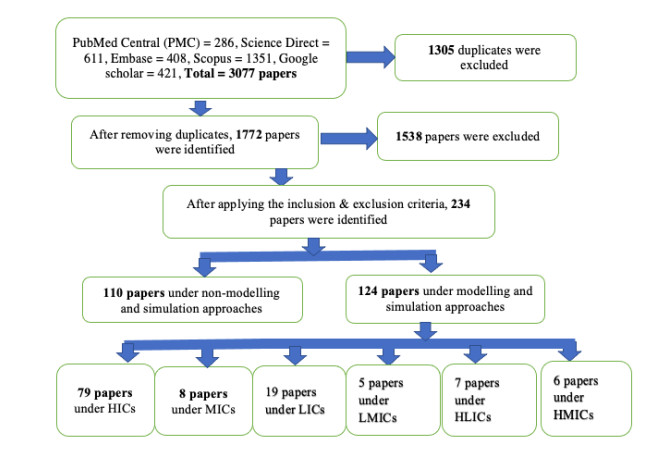









 DownLoad:
DownLoad:
